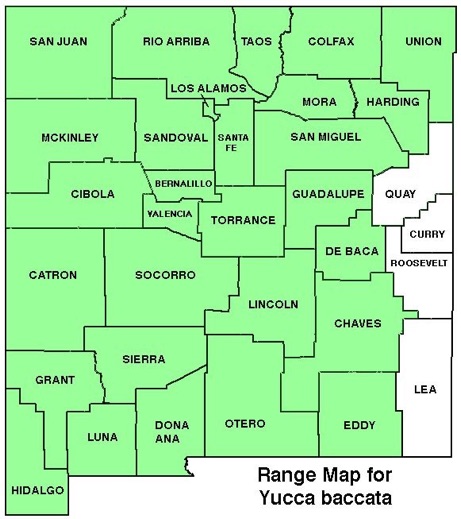WILDFLOWERS OF NEW MEXICO

Unlike many yuccas, this species is easy to identify. It has stout, rigid, sword-like leaves, no trunk (or less than a 12-inch in old specimens), a bloom-stalk within the leaves, and fleshy, banana-shaped fruit. Banana yuccas make popular landscape plants.
FLOWER: April–July. The flower stalk emerges only slightly above the leaves and bears a long, dense, spike-like cluster of creamy-white, fleshy, egg-shaped, flowers 2–5 1/8-inches long (5–13 cm). The fruit matures into a banana-shaped, succulent, 2–9-inch long (5–22 cm) pod that when roasted was an important food item for desert Indians. Variety baccata may have short stems less than 12 inches long.
LEAVES: Basal. Sword-like leaves 12–40-inches long (30–100 cm) by 3/4–2 3/8-inches wide (2–6 cm), grow in a dense rosette and have smooth margins with curling threads, and are tipped with a vicious, 1-inch long (25 mm) needle.
HABITAT: Rocky, sandy soils; desert hills, grasslands, and scrub, pinyon-juniper woodlands.
ELEVATION: 4,200–8,600 feet.
RANGE: AZ, CA, CO, NM, NV, UT, TX.
SIMILAR SPECIES: Other yuccas without stems or trunks have narrow or flexible leaves, and pods that dry into a hard, egg-shaped capsule, or tall bloom stalks (Y. elata) that reach high above the leaves.
NM COUNTIES: In low- to mid-elevation arid habitats statewide except the plains counties of Curry, Lea, Quay, Roosevelt.
NOTES: The versatile yucca plant was an important source of food, fiber, medicine for Native Americans. The flower petals, high in vitamin C, are edible, and the fruit of the soft-fruited species like the Banana Yucca, with the seeds removed, were baked, roasted, dried, and boiled. Fibers from the leaves provided cordage, and the saponin-rich roots were, and still are, prized as a high-quality soap and shampoo.









BANANA YUCCA, DATIL
YUCCA BACCATA
Asparagus Family, Asparagaceae (formerly in Agave Family, Agavaceae)
Perennial shrub


















THE CONTENTS OF THIS WEBSITE ARE COPYRIGHTED AND CANNOT BE USED
WITHOUT PERMISSION OF GEORGE OXFORD MILLER












































The strong fibers in the leaves were uses for thread, rope, nets, and other utility objects.
When roasted, the succulent fruit was an important food item for desert Indians.

















EMAIL ME







